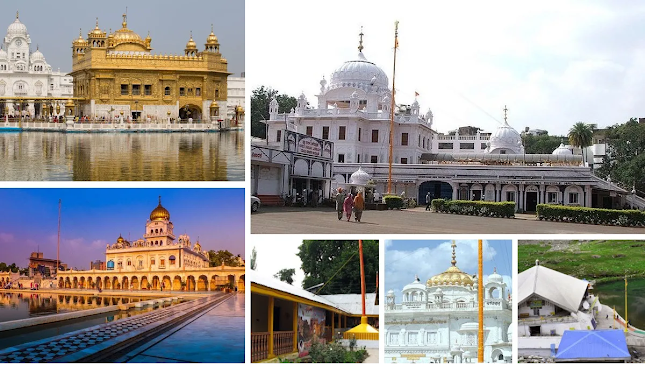A Tour of Gurudwaras in India
India, a land rich in
diversity and spirituality, is home to numerous Gurudwaras—sacred places of
worship for Sikhs. These Gurudwaras not only serve as religious centers but
also stand as symbols of equality, community service, and devotion. Embarking
on a tour of Gurudwaras across India offers a profound journey through Sikh
history, culture, and architecture, providing spiritual nourishment and
cultural enlightenment to visitors.
The history of Gurudwaras is
deeply intertwined with the Sikh faith's origins and the life stories of its
revered gurus. The first Guru, Guru Nanak Dev Ji, laid the foundation of
Sikhism in the 15th century, preaching the principles of equality, compassion,
and service to humanity. Over time, subsequent Gurus expanded Sikhism, each
leaving their mark on the religion's development.
Gurudwaras exhibit a
distinctive architectural style that reflects the ethos of Sikhism while
incorporating elements of regional art and culture. The most iconic feature of
Gurudwaras is the gilded dome, symbolizing the sovereignty of God. The sanctum,
known as the Darbar Sahib, houses the Guru Granth Sahib—the holy scripture of
Sikhism. Langar halls, where free meals are served to all visitors irrespective
of caste, creed, or religion, are integral parts of Gurudwara complexes.
Religious Practices and Rituals
Visiting a Gurudwara
involves participating in various religious rituals and practices. Devotees pay
their respects by bowing before the Guru Granth Sahib and offering prayers. The
recitation of hymns, known as Kirtan, fills the atmosphere with divine
melodies, fostering a sense of spiritual serenity. Partaking in the langar, or
communal meal, epitomizes the Sikh principle of seva (selfless service) and
underscores the importance of equality and inclusivity.
Gurudwaras serve as cultural
hubs where people from diverse backgrounds come together to celebrate
festivals, commemorate historical events, and engage in community activities.
Festivals like Gurpurabs, marking the birth anniversaries of Sikh Gurus, and
Vaisakhi, commemorating the formation of the Khalsa Panth, are celebrated with
great fervor and enthusiasm. Nagar Kirtans, processions accompanied by
devotional singing and martial arts displays, showcase the vibrant cultural
heritage of Sikhism.
Notable Gurudwaras Across
India
Golden Temple (Harmandir Sahib) - Amritsar, Punjab
The Golden Temple, also
known as Harmandir Sahib, stands as the holiest shrine in Sikhism. Its
resplendent golden facade, set amidst a tranquil water tank (Sarovar), exudes
an aura of divine grace. The temple complex encompasses the Akal Takht, the
highest temporal seat of Sikh authority, and the langar hall, which serves
thousands of devotees daily. The atmosphere of spirituality and devotion at the
Golden Temple is unparalleled, drawing millions of pilgrims from around the
world.
Hemkund Sahib - Chamoli, Uttarakhand
Nestled amidst the majestic
Himalayas, Hemkund Sahib is a revered pilgrimage site for Sikhs and Hindus
alike. Situated at an altitude of over 15,000 feet, this Gurudwara is
accessible only during the summer months when the snow melts. Devotees
undertake a challenging trek through rugged terrain to reach Hemkund Sahib,
where they find solace in the pristine surroundings and the tranquil waters of
the sacred lake. The Gurudwara's picturesque location and serene ambiance make
it a must-visit destination for spiritual seekers and nature enthusiasts.
Bangla Sahib - New Delhi
Located in the heart of
India's capital city, Bangla Sahib Gurudwara is a haven of peace amid the
bustling urban landscape. Its distinctive white facade and golden dome stand as
beacons of hope and spirituality for millions of visitors. Bangla Sahib is
renowned for its massive langar operation, feeding thousands of people daily,
regardless of their social or economic status. The Gurudwara's serene
surroundings, including a serene pool (Sarovar) and lush green gardens, provide
a welcome retreat from the city's chaos, inviting visitors to experience
moments of tranquility and introspection.
Anandpur Sahib - Rupnagar,
Punjab
Anandpur Sahib holds immense
historical and religious significance as the birthplace of the Khalsa and the
site of several key events in Sikh history. The sprawling complex of Anandpur
Sahib includes historical Gurdwaras such as Takht Sri Kesgarh Sahib and
Gurdwara Sis Ganj Sahib, each commemorating pivotal moments in Sikh history.
The annual Hola Mohalla festival, celebrated with great pomp and fervor,
attracts thousands of devotees and tourists who witness martial arts displays,
mock battles, and religious processions.
Patna Sahib - Patna, Bihar
Patna Sahib, also known as
Takht Sri Harmandir Sahib, is revered as the birthplace of Guru Gobind Singh
Ji, the tenth Sikh Guru. The Gurudwara complex comprises the main shrine, a
museum showcasing Sikh artifacts and historical relics, and a spacious langar
hall catering to the needs of pilgrims. Patna Sahib holds special significance
during Guru Gobind Singh Ji's birth anniversary celebrations, known as Prakash
Utsav, which attract devotees from far and wide to seek blessings and pay
homage to the Guru's legacy.
Conclusion
A tour of Gurudwaras in
India offers a transformative journey of spiritual awakening, cultural
immersion, and historical enlightenment. Whether it's the majestic splendor of
the Golden Temple, the rugged beauty of Hemkund Sahib, or the serene ambiance
of Bangla Sahib, each Gurudwara beckons pilgrims and travelers to experience
the divine presence and embrace the timeless teachings of Sikhism. As visitors
embark on this sacred odyssey, they not only discover the profound legacy of
Sikh Gurus but also forge lasting connections with the rich tapestry of Indian
spirituality and culture.









Comments
Post a Comment